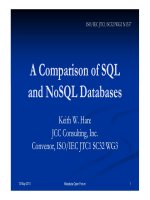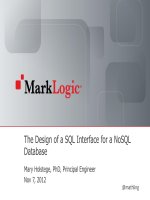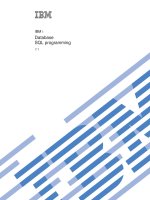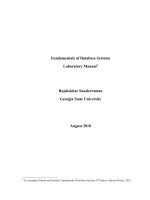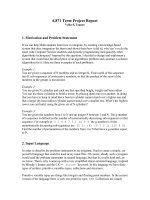TÀI LIỆU - Cao Học Khóa 8 - ĐH CNTT 5. c NOSQL
Bạn đang xem bản rút gọn của tài liệu. Xem và tải ngay bản đầy đủ của tài liệu tại đây (1.69 MB, 41 trang )
ISO/IEC JTC1/SC32/WG2 N1537
A Comparison of SQL
and NoSQL Databases
Keith W. Hare
JCC Consulting, Inc.
Convenor, ISO/IEC JTC1 SC32 WG3
13 May 2011
Metadata Open Forum
1
Abstract
NoSQL databases (either no
no--SQL or Not Only
SQL) are currently a hot topic in some parts of
computing. In fact, one website lists over a
hundred different NoSQL databases.
This presentation reviews the features common to
the NoSQL databases and compares those features
to the features and capabilities of SQL databases.
13 May 2011
Metadata Open Forum
2
Who Am I?
Muskingum College, 1980, BS in Biology and
Computer Science
Senior Consultant with JCC Consulting, Inc.
since 1985 – high performance database systems
Ohio State – Masters in Computer &
Information Science, 1985
SQL Standards committees since 1988
Vice Chair, INCITS H2 since 2003
Convenor, ISO/IEC JTC1 SC32 WG3 since
2005
13 May 2011
Metadata Open Forum
3
Topics
SQL Databases
SQL Standard
SQL Characteristics
SQL Database Examples
NoSQL Databases
NoSQL Defintion
General Characteristics
NoSQL Database Types
NoSQL Database Examples
13 May 2011
Metadata Open Forum
4
Standard SQL
The following is a short, incomplete history of the SQL
Standards – ISO/IEC 9075
1987 – Initial ISO/IEC Standard
1989 – Referential Integrity
1992 – SQL2
1995 SQL/CLI (ODBC)
1996 SQL/PSM – Procedural Language extensions
1999 – User Defined Types
2003 – SQL/XML
2008 – Expansions and corrections
2011 (or 2012) System Versioned and Application Time
Period Tables
13 May 2011
Metadata Open Forum
5
SQL Characteristics
Data stored in columns and tables
Relationships represented by data
Data Manipulation Language
Data Definition Language
Transactions
Abstraction from physical layer
13 May 2011
Metadata Open Forum
6
SQL Physical Layer Abstraction
Applications specify what, not how
Query optimization engine
Physical layer can change without modifying
applications
Create indexes to support queries
In Memory databases
13 May 2011
Metadata Open Forum
7
Data Manipulation Language (DML)
Data manipulated with Select, Insert, Update, &
Delete statements
Select T1.Column1, T2.Column2 …
From Table1, Table2 …
Where T1.Column1 = T2.Column1 …
Data Aggregation
Compound statements
Functions and Procedures
Explicit transaction control
13 May 2011
Metadata Open Forum
8
Data Definition Language
Schema defined at the start
Create Table (Column1 Datatype1, Column2 Datatype
2, …)
Constraints to define and enforce relationships
Primary Key
Foreign Key
Etc.
Triggers to respond to Insert, Update , & Delete
Stored Modules
Alter …
Drop …
Security and Access Control
13 May 2011
Metadata Open Forum
9
Transactions – ACID Properties
Atomic – All of the work in a transaction completes
(commit) or none of it completes
Consistent – A transaction transforms the database
from one consistent state to another consistent
state. Consistency is defined in terms of constraints.
Isolated – The results of any changes made during a
transaction are not visible until the transaction has
committed.
Durable – The results of a committed transaction
survive failures
13 May 2011
Metadata Open Forum
10
SQL Database Examples
Commercial
IBM DB2
Oracle RDMS
Microsoft SQL Server
Sybase SQL Anywhere
Open Source (with commercial options)
MySQL
Ingres
Significant portions of the
world’s economy use SQL databases!
13 May 2011
Metadata Open Forum
11
NoSQL Definition
From www.nosql
www.nosql--database.org:
Next Generation Databases mostly addressing some of
the points: being non
non--relational, distributed,
distributed, open
open-source and horizontal scalable.
scalable. The original intention
has been modern web
web--scale databases.
databases. The
movement began early 2009 and is growing rapidly.
Often more characteristics apply as: schema
schema--free,
easy replication support, simple API, eventually
consistent / BASE (not ACID), a huge data
amount,
amount, and more.
13 May 2011
Metadata Open Forum
12
NoSQL Products/Projects
ql
lists 122 NoSQL
Databases
Cassandra
CouchDB
Hadoop & Hbase
MongoDB
StupidDB
Etc.
13 May 2011
Metadata Open Forum
13
NoSQL Distinguishing Characteristics
Large data volumes
Scalable replication and distribution
Google’s “big data”
Potentially thousands of machines
Potentially distributed around the world
Queries need to return answers quickly
Mostly query, few updates
Asynchronous Inserts & Updates
SchemaSchema-less
ACID transaction properties are not needed – BASE
CAP Theorem
Open source development
13 May 2011
Metadata Open Forum
14
BASE Transactions
Acronym contrived to be the opposite of ACID
Basically Available,
vailable,
Soft state,
Eventually Consistent
Characteristics
Weak consistency – stale data OK
Availability first
Best effort
Approximate answers OK
Aggressive (optimistic)
Simpler and faster
13 May 2011
Metadata Open Forum
15
Brewer’s CAP Theorem
A distributed system can support only two of the
following characteristics:
Consistency
Availability
Partition tolerance
The slides from Brewer’s July 2000 talk do not
define these characteristics.
13 May 2011
Metadata Open Forum
16
Consistency
all nodes see the same data at the same time –
Wikipedia
client perceives that a set of operations has
occurred all at once – Pritchett
More like Atomic in ACID transaction
properties
13 May 2011
Metadata Open Forum
17
Availability
node failures do not prevent survivors from
continuing to operate – Wikipedia
Every operation must terminate in an intended
response – Pritchett
13 May 2011
Metadata Open Forum
18
Partition Tolerance
the system continues to operate despite arbitrary
message loss – Wikipedia
Operations will complete, even if individual
components are unavailable – Pritchett
13 May 2011
Metadata Open Forum
19
NoSQL Database Types
Discussing NoSQL databases is complicated
because there are a variety of types:
Column Store – Each storage block contains
data from only one column
Document Store – stores documents made up of
tagged elements
Key
Key--Value Store – Hash table of keys
13 May 2011
Metadata Open Forum
20
Other Non
Non--SQL Databases
XML Databases
Graph Databases
Codasyl Databases
Object Oriented Databases
Etc…
Will not address these today
13 May 2011
Metadata Open Forum
21
NoSQL Example: Column Store
Each storage block contains data from only one
column
Example: Hadoop
Hadoop/
/Hbase
/> Yahoo, Facebook
Example: Ingres VectorWise
Column Store integrated with an SQL database
/>
13 May 2011
Metadata Open Forum
22
Column Store Comments
More efficient than row (or document) store if:
Multiple row/record/documents are inserted at the
same time so updates of column blocks can be
aggregated
Retrievals access only some of the columns in a
row/record/document
13 May 2011
Metadata Open Forum
23
NoSQL Example: Document Store
Example: CouchDB
/> /> BBC
Example: MongoDB
/> /> Foursquare, Shutterfly
JSON – JavaScript Object Notation
13 May 2011
Metadata Open Forum
24
CouchDB JSON Example
{
"_id": "guid
"guid goes here",
"_rev": "314159",
"type": "abstract",
"author": "Keith W. Hare"
"title": "SQL Standard and NoSQL Databases",
"body": "NoSQL
"NoSQL databases (either nono-SQL or Not Only SQL)
are currently a hot topic in some parts of
computing.",
"creation_timestamp":
creation_timestamp": "2011/05/10 13:30:00 +0004"
}
13 May 2011
Metadata Open Forum
25


